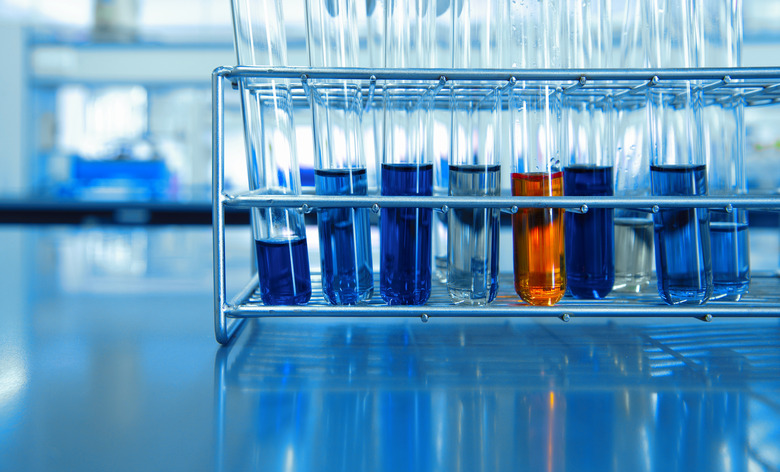How Is The Equilibrium Constant Of A Reaction Determined?
Reversible reactions occur in both directions, but every reversible reaction settles down to an "equilibrium" position. If you want to characterize the equilibrium of such a reaction, the equilibrium constant describes the balance between the products and reactants. Calculating the equilibrium constant requires knowledge of the concentrations of the products and the reactants in the reaction when it's at equilibrium. The value of the constant also depends on the temperature and whether the reaction is exothermic or endothermic.
TL;DR (Too Long; Didn't Read)
For the generic reaction:
**aA(g) + bB(g) ⇌ gG(g) + hH(g)**
Here, the lower case letters are the number of moles of each, the upper case letters stand in for the chemical components of the reaction, and the letters in parentheses represent the state of matter. You find the equilibrium constant of concentration with the expression:
**Kc = [G]g [H]h ÷ [A]a[B]b**
For exothermic reactions, increasing the temperature reduces the value of the constant, and for endothermic reactions, increasing the temperature increases the value of the constant.
Calculating the Equilibrium Constant
Calculating the
Equilibrium Constant
The formula for the equilibrium constant makes references to a generic "homogeneous" reaction (where the states of matter for the products and reactants are the same), which is:
**aA(g) + bB(g) ⇌ gG(g) + hH(g)**
Where the lower case letters represent the numbers of moles of each component in the reaction, and the upper case letters stand in for the chemicals involved in the reaction and the letter (g) in brackets represent the state of matter (gas, in this case).
The following expression defines the equilibrium constant of concentration (Kc):
**Kc = [G]g [H]h ÷ [A]a[B]b**
Here, the square brackets are for the concentrations (in moles per liter) for each of the components of the reaction, at equilibrium. Note that the moles of each component in the original reaction are now exponents in the expression. If the reaction favors the products, then the result will be greater than 1. If it favors the reactants, it will be less than 1.
For inhomogeneous reactions, the calculations are the same, except solids, pure liquids and solvents are all simply counted as 1 in the calculations.
The equilibrium constant of pressure (Kp) is really similar, but it is used for reactions involving gases. Instead of the concentrations, it uses partial pressures of each component:
**Kp = pGg pHh ÷ pAa pBb**
Here, (pG) is the pressure of component (G) and so on, and the lower case letters represent the number of moles in the equation for the reaction.
You perform these calculations in quite a similar way, but it depends on how much you know about the quantities or pressures of the products and reactants at equilibrium. You can determine the constant using known initial amounts and one equilibrium amount with a bit of algebra, but generally it's more straightforward with known equilibrium concentrations or pressures.
How Temperature Affects the Equilibrium Constant
How Temperature Affects the Equilibrium Constant
Changing the pressure or the concentrations of the things present in the mixture doesn't change the equilibrium constant, although both of these may affect the position of equilibrium. These changes tend to undo the effect of the change you made.
Temperature, on the other hand, does change the equilibrium constant. For an exothermic reaction (ones that release heat), increasing the temperature reduces the value of the equilibrium constant. For endothermic reactions, which absorb heat, increasing the temperature increases the value of the equilibrium constant. The specific relationship is described in the van't Hoff equation:
**ln (K2 ÷** K1) = (−∆H0 **÷** R) × ( 1/T2 – 1/T1)
Where (∆H0) is the change in enthalpy of the reaction, (R) is the universal gas constant, (T1) and (T2) are the starting and final temperatures, and (K1) and (K2) are the starting and final values of the constant.
Cite This Article
MLA
Johnson, Lee. "How Is The Equilibrium Constant Of A Reaction Determined?" sciencing.com, https://www.sciencing.com/how-is-the-equilibrium-constant-of-a-reaction-determined-13710448/. 28 March 2018.
APA
Johnson, Lee. (2018, March 28). How Is The Equilibrium Constant Of A Reaction Determined?. sciencing.com. Retrieved from https://www.sciencing.com/how-is-the-equilibrium-constant-of-a-reaction-determined-13710448/
Chicago
Johnson, Lee. How Is The Equilibrium Constant Of A Reaction Determined? last modified March 24, 2022. https://www.sciencing.com/how-is-the-equilibrium-constant-of-a-reaction-determined-13710448/
